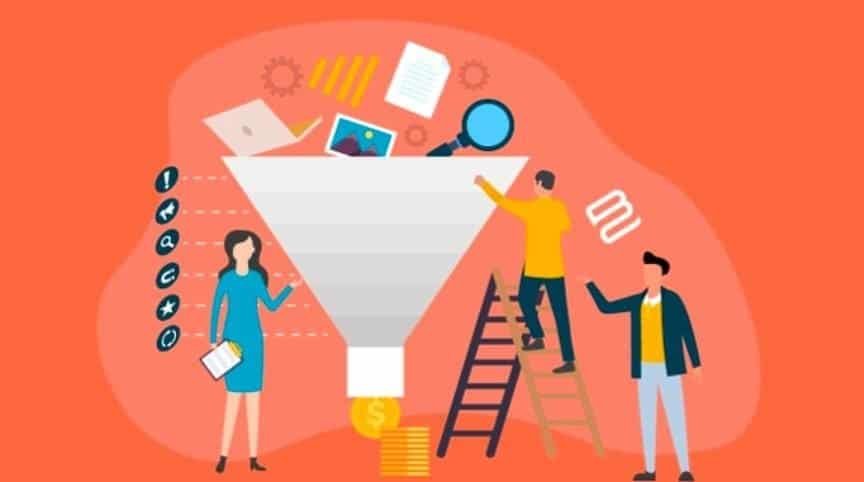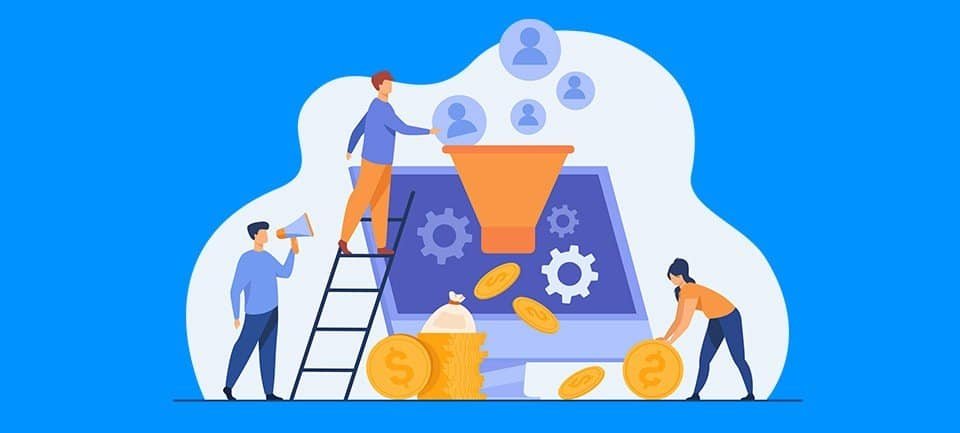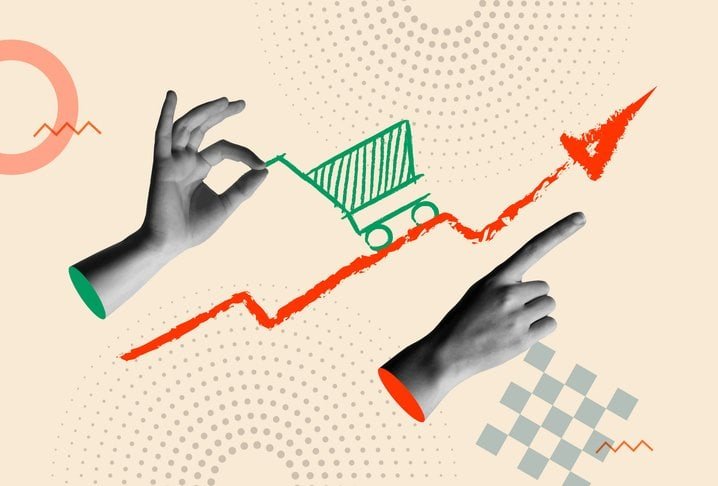Hey man! Let’s talk about sales funnels! They’re like a secret weapon for businesses of all shapes and sizes. You know that feeling when you see a magic trick and wonder, “How did they do that?!” That’s kind of what a well-oiled sales funnel can do for your business—it can magically transform prospects into loyal, paying customers.
What Exactly is a Sales Funnel and Why Should I Care?
Imagine a funnel. You pour something in at the top, and it comes out the bottom in a more concentrated form, right? That’s basically how a sales funnel works! You start with a wide audience of potential customers at the top. As they move through the funnel, you nurture their interest and guide them toward a purchase decision.
Think of it as a structured customer journey, like a roadmap leading them from initial awareness to becoming raving fans of your brand.
Why are sales funnels so important? Buckle Up, This is Game-Changing
You might be thinking, “Okay, that sounds interesting, but why should I really care?” Well, my friend, here’s the juicy stuff: sales funnels are essential because they:
- Skyrocket Conversion Rates: Sales funnels aren’t just about getting people in the door; they’re about converting those visitors into paying customers. By systematically addressing each stage of the customer journey, you can identify and smooth out any bumps in the road, making it more likely that people will stick around and ultimately make a purchase.
- Laser-Focused Targeting: One size doesn’t fit all in the world of marketing! Sales funnels let you segment your audience based on where they are in the funnel, making your marketing efforts super-personalized. This means that the right message reaches the right people at the right time—talk about maximizing your impact!
- Unlock the Secrets of Customer Insights: Every interaction a potential customer has with your funnel is a goldmine of information. This data reveals their behavior, preferences, and pain points, allowing you to refine your marketing strategies, create products that truly hit the mark, and communicate with customers in a way that resonates.
- Watch Your Sales Revenue Soar: Okay, let’s talk about the bottom line—sales revenue. A well-optimized sales funnel is like a money-making machine, nurturing potential customers, gently nudging them toward a purchase, and ultimately boosting your profits. It’s about capitalizing on opportunities that might otherwise slip through the cracks!

Dismantling the Myth: Busting Common Misconceptions About Sales Funnels
Before we dive deeper, let’s clear up a few misconceptions that often surround sales funnels.
Myth 1: Sales Funnels are Only for Big Businesses
Fact: Sales funnels are for everyone! Whether you’re a solopreneur running an Etsy shop or a multinational corporation, the principles of guiding customers through a structured journey remain the same. Adapt the complexity to suit your business size and needs!
Myth 2: Sales Funnels are Manipulative and Pushy
Fact: Done right, sales funnels are about building relationships and providing value, not about pressure tactics. The focus is on understanding your audience, addressing their needs, and creating a seamless, enjoyable experience that naturally leads to a purchase.
Myth 3: Setting Up a Sales Funnel is Too Complicated and Time-Consuming
Fact: While setting up a robust sales funnel might take some initial effort, the benefits far outweigh the investment. Plus, there are tons of tools and resources available to simplify the process, even for beginners.
Decoding the Stages of a Sales Funnel: From Stranger to Superfan
Now that we’ve busted some myths, let’s break down the typical stages of a sales funnel:
Stage 1: Awareness—Hello, World!
This is where the magic begins. You’ve got an amazing product or service, but nobody knows about it yet. The awareness stage is all about getting the word out there! Think social media campaigns, captivating blog posts, search engine optimization—anything that helps you shout from the rooftops, “Hey, we exist! And we’re here to solve your problems!”
Stage 2: Interest—Piquing Their Curiosity
You’ve caught their attention; now it’s time to reel them in! The interest stage is about providing valuable content that resonates with your target audience, sparking their curiosity, and demonstrating how you can solve their pain points. Think engaging videos, informative ebooks, interactive quizzes—anything that keeps them wanting more.
Stage 3: Evaluation—Weighing the Options
Now your potential customer is actively considering whether your product or service is the right fit for them. They’re comparing you to competitors, reading reviews, and doing their research. This is where you need to shine! Provide in-depth product descriptions, case studies showcasing your success stories, and glowing testimonials from happy customers.
Stage 4: Decision: Time to Seal the Deal
Decision time! Your prospect is on the verge of making a purchase, but they might need a little nudge. This is where irresistible offers come in, like limited-time discounts, free trials, or bonus bundles. Make it easy for them to say “Yes!” and give them that final push to convert.
Stage 5: Purchase – Cha-Ching!
Congratulations! You’ve made a sale! But the journey doesn’t end here. The purchase stage is about ensuring a smooth and enjoyable checkout experience. Make the process effortless, secure, and user-friendly to minimize cart abandonment and leave a positive, lasting impression.
Stage 6: Loyalty – Building Lasting Bonds
You’ve got a customer; now it’s time to turn them into a loyal fan! The loyalty stage is about nurturing the relationship you’ve built, exceeding expectations, and providing exceptional customer service. Think personalized follow-up emails, exclusive loyalty programs, and going above and beyond to demonstrate that you value their business.
Stage 7: Advocacy—Unleashing the Power of Word-of-Mouth
The holy grail of marketing—turning your customers into enthusiastic brand advocates! When customers love your brand, they naturally tell their friends and family about it, generating organic word-of-mouth marketing that’s more powerful than any paid advertising. Encourage advocacy by creating shareable content, running referral programs, and providing exceptional experiences that people can’t help but rave about.

Why Funnels Are More Than Just a Buzzword—They’re Data-Driven Goldmines
One of the most powerful aspects of sales funnels is their ability to provide valuable insights into your customer journey. You can track key metrics at each stage, like conversion rates, bounce rates, and time spent on page, to identify areas for improvement and optimize your funnel for maximum effectiveness.
Crafting a Sales Funnel That Converts Like Crazy: Your Step-by-Step Guide
Ready to build your own high-converting sales funnel? Here’s a roadmap to get you started:
- Know Your Audience: Who are you trying to reach? What are their pain points, desires, and aspirations? The more deeply you understand your target audience, the better you can tailor your message and offerings to resonate with them.
- Craft Irresistible Content: Content is king! Create valuable, engaging content that addresses your audience’s needs and guides them through each stage of the funnel. Think blog posts, videos, infographics, ebooks, webinars—anything that educates, entertains, and adds value.
- Build Landing Pages That Convert: Landing pages are dedicated pages designed to capture leads and move them further down the funnel. Optimize them for conversions with compelling headlines, clear calls to action, and a distraction-free design that focuses on the desired action.
- Harness the Power of Email Marketing: Email is a powerful tool for nurturing leads, providing valuable information, and promoting offers. Segment your email list based on the funnel stage and personalize your messages for maximum impact.
- Embrace the World of Social Media: Social media platforms offer a fantastic way to connect with your target audience, build brand awareness, and drive traffic to your funnel. Use a mix of organic content and paid advertising to maximize your reach and engagement.
- Leverage Paid Advertising: Paid advertising can be a powerful way to reach a wider audience and accelerate your funnel’s growth. Experiment with different platforms and ad formats to find what works best for your business.
- Analyze, Optimize, Repeat: The work doesn’t stop once you’ve built your funnel! Continuously track key metrics, analyze the data, and make adjustments based on what you learn. A/B testing different elements of your funnel is crucial for ongoing optimization.
The Ultimate Goal—Creating a Sales Funnel That Feels Effortless
Remember, a well-designed sales funnel should feel natural and effortless to your potential customers. It’s about guiding them gently through each stage, providing value at every step, and building a relationship that ultimately leads to a mutually beneficial outcome.

Real-World Examples of Sales Funnels in Action: Inspiration from the Pros
Let’s take a look at some real-world examples of how businesses are effectively using sales funnels to achieve remarkable results:
Example 1: E-commerce Giant: Amazon
Amazon is a master of sales funnels. From personalized product recommendations to targeted email campaigns and a seamless checkout process, they’ve created a system that effortlessly guides customers from browsing to buying. Their Prime membership program is a prime example (pun intended!) of building customer loyalty and increasing lifetime value.
Example 2: Software as a Service (SaaS) – HubSpot
HubSpot, a leading marketing and sales software company, is renowned for its inbound marketing methodology, which heavily relies on sales funnels. They offer valuable content like blog posts, ebooks, and webinars to attract leads, nurture their interest, and ultimately convert them into paying customers.
Example 3: Online Course Creator, Amy Porterfield
Amy Porterfield, a successful online course creator, is known for her strategic use of webinars to generate leads and promote her courses. Her webinars are designed to educate and engage viewers, build trust and authority, and ultimately lead to sales. She uses a combination of email marketing, social media promotion, and paid advertising to drive traffic to her webinars.
Conclusion
In today’s competitive digital landscape, sales funnels are no longer a “nice-to-have,” they’re a “must-have” for any business that wants to succeed. They empower you to attract, engage, and convert customers more effectively, build lasting relationships, and ultimately achieve sustainable growth.
Don’t let your business get lost in the digital noise. Embrace the power of sales funnels and watch your conversions soar!
FAQs
How Long Does It Take to See Results from a Sales Funnel? The time it takes to see results from a sales funnel varies depending on factors like your industry, target audience, and the effectiveness of your funnel. However, with consistent effort and optimization, you can start seeing positive results within a few months.
What are some common mistakes to avoid when building a sales funnel? Some common mistakes to avoid include:
- Not clearly defining your target audience
- Creating content that doesn’t resonate with your audience
- Not optimizing landing pages for conversions
- Neglecting the post-purchase experience
- Not tracking and analyzing your funnel’s performance
What are Some Recommended Tools for Building Sales Funnels? There are tons of great tools available to help you build and manage your sales funnels. Some popular options include:
- ClickFunnels: An all-in-one platform for building high-converting funnels
- Leadpages: A landing page builder with a focus on conversions
- Mailchimp: An email marketing platform with automation features
- HubSpot: A comprehensive marketing and sales software suite

